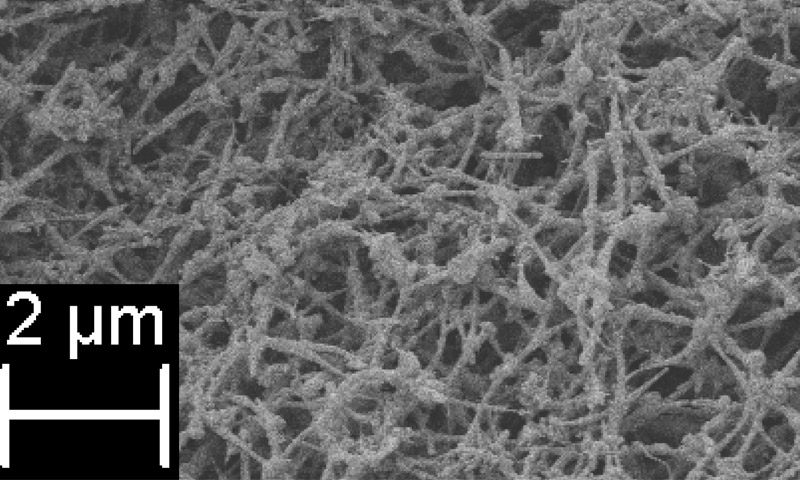Coupling applied research with defense-focused education, the Naval Postgraduate School (NPS) has entered into a Cooperative Research and Development Agreement (CRADA) with BNNano, an advanced manufacturing company known for producing revolutionary Boron Nitride Nanotubes, to test and evaluate Boron Nitride nanomaterials for potential defense applications.
Boron Nitride Nanotubes are a revolutionary nanomaterial that exhibits a desirable combination of exceptional physical and chemical properties to include high thermal conductivity, electrical resistivity, superhydrophobicity and high thermal stability, strength and stiffness. Applications may include electric insulation, fire retardants, radiation shielding, metal lightening, and corrosion resistance.
The CRADA will allow faculty and students from NPS’ Mechanical and Aerospace Engineering (MAE) Department to test BNNano’s proprietary NanobarbTM, a Boron Nitride Nanotube embedded with mechanical barbs designed to enhance reinforcing properties.
MAE faculty, Drs. Claudia Luhrs, Emre Gunduz, and Andy Nieto, are NPS’ key collaborators incorporating the NanobarbTM into their research, which tailors materials’ properties resulting in nanomaterials with a wide range of applications (i.e., supercapacitors, impact resistant structural components, microelectronics, high temperature systems and conductive aerospace composite structures). The researchers plan to look into enhancing the thermal conductivity of lightweight carbon composites used by the aerospace industry as well as phase change materials to optimize temperature regulation systems in living and storage spaces.
“The idea is to see how the properties of the material compares to the applications where we’re already using boron nitride,” said Luhrs. “Each of us has individual projects in which we are using boron nitride, and [BNNano’s] part of the collaboration is providing the materials while we evaluate it and share the data as how effective it might be for different applications.”
Nanomaterials are not necessarily an inexpensive resource, but due to the CRADA, the NPS students who come to NPS with operational experience to research warfighting solutions as they get their graduate education, now have more access to them for research.
“We’re basically augmenting existing projects with this, taking note of research results and the students’ experience,” said Gunduz. “I think that works for both sides. There are some theoretical potential gains in the performance by using even small amounts of these additives in the regular metal or other things.”
According to Nieto, student and faculty research at NPS has the ability to accelerate applied research solutions to key operational problems.
“There’s plenty of opportunities on these projects,” said Nieto. “For the most part, the research at NPS is focused on defense or Navy purposes. Ideally, these students will take what they learn and apply it to challenges directly forward [in the Fleet].”
In fact, the collaboration between NPS and BNNano is the direct result of an NPS alumnus applying his NPS experience while working to advance nanotechnology. While working with BNNano, NPS Systems Technology graduate and retired Marine Corps Lt. Col. Scott Kish saw potential applications of their nanotechnology within DOD capabilities, and worked to connect the company with NPS to develop potential breakthroughs.
“The idea that BNNano should collaborate with NPS came from my military experience and military educational opportunities,” said Kish. “I was fortunate to receive all my education from U.S. Navy institutions starting with the Naval Academy, but it was at NPS where I was able to participate in a variety of study opportunities that provided us innovative and creative ways to develop solutions to Navy and Marine Corps challenges.”
While studying at NPS, Kish remembered how NPS was involved with private industry. He realized that using commercial platforms to help address military challenges can have a tremendous impact, so he discussed the opportunity with the leadership at BNNano who were quick to support the endeavor.
“We believe that our boron nitride nanobarbs may have a tremendous impact on a number of military capabilities. When we first started testing our nanomaterial, it was quickly apparent that the technology could help transform maritime capabilities due to its properties and we thought that NPS was the perfect partner to research opportunities to assist the US Navy and DoD,” said Steve Wilcenski, BNNano’s CEO and Co-Founder.
Teaming up with private technology companies through CRADAs not only benefits the university and the DOD, but the partnering company as well.
“NPS brings a number of research capabilities to the table that will benefit the DoD and BNNano. They have world-class research and laboratory facilities. The other element that BNNano is excited about is the opportunity for the NPS students to get experience in working with our nanomaterials,” said Jason Taylor, BNNano’s Chief Technology Officer and Co-Founder.


